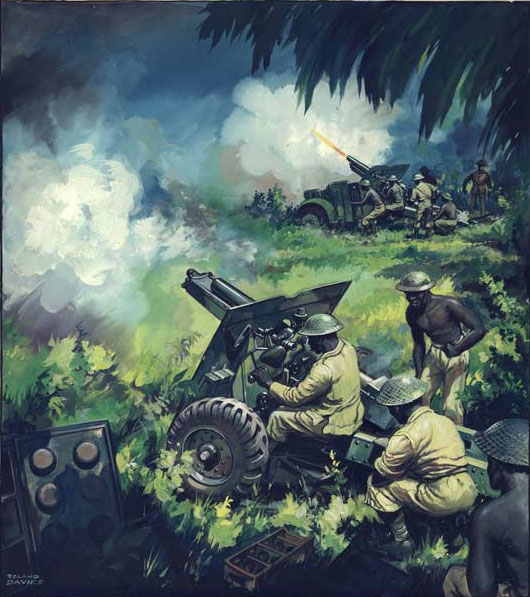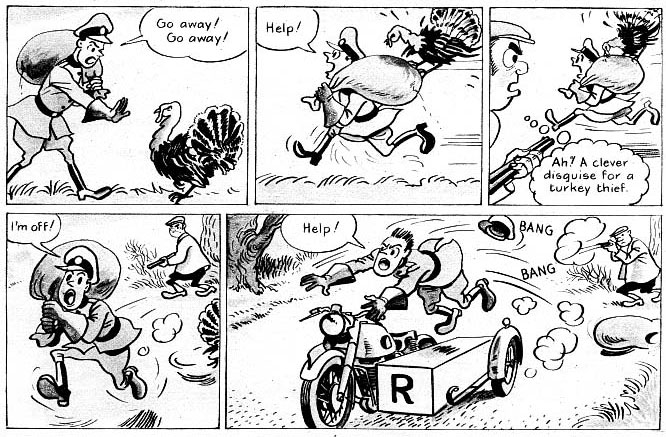'Sexton Blake and the Red Rapier' (Knock-Out #570, 1950).
Roland Davies was a British comic artist, political cartoonist and animator. He was the creator of the long-running pantomime gag strip 'Come on, Steve' (1932-1949). Davies founded his own animation studio to adapt this comic into six animated shorts, making him also a pioneer in British animation. While Davies created children's comics in many different genres (humor, western, detective, boys' comics, girls' comics, funny animal, science fiction) he is best remembered for his artwork involving cars and motorcycles, like in his comics features 'Sparks and Flash' (1949) and 'Roddy, the Road Scout' (1954-1963).
1931 card illustration for Ogden's Cigarettes, printed by Mardon, Son & Hall.
Early life and career
Roland Oxford Davies was born in 1904 (some sources have erroneously claimed 1910) in Stourbridge, Worcestershire. His father was a conductor of a theater orchestra, from Welsh descent. Davies studied at the Ipswich School of Art and worked for a lithographic printing firm, where he created film posters. One of his illustrations was used by the Metropolitan Railway. Davies was always fond of fast vehicles and thus he regarded this railway poster as one of his proudest achievements. Soon enough the road opened for him as well, as he created various action-packed illustrations for niche magazines like Motor Cycle and Autocar and boys' magazines like Chums, Modern Boy and The Champion. He also showed his skills in a series of racing cards for Ogden's Cigarettes through the printing company Mardon, Son & Hall in 1931.
Come On, Steve!
Oddly enough, Davies' first long-running comic strip dealt with a traditional means of transport, namely a horse. On 6 March 1932, the pantomime gag comic 'Come On, Steve!' (occasionally spelled without a comma too, 1932-1949) made its debut in The Sunday Express. All gags centered around an intrusive but essentially good-natured carthorse named Steve. His name was a tribute to famous champion racehorse jockey Steve Donoghue. The comic strip was popular at the time and led to a few annual compilation books and twelve color picture books. In 1939, the Sunday Express dropped 'Come On, Steve!', which motivated the cartoonist to move to a different paper, the Sunday Dispatch, where the antics of good ol' Steve continued until 1949. Davies published political cartoons for this same paper under the pseudonym "Rod".
Animation
In 1936, Davies went through the effort of founding his own animation studio, Roland Davies Films Ltd., simply to create an animated short based on his comic 'Come On, Steve!'. The original studio was located in his kitchen. With a cheap stop-frame cine camera he spent seven months on his dream project. At the time, there were no books about animation and Davies therefore had to learn everything by trial and error. His only guide was three pages in an old book. One of his mistakes was placing the cel-pegs at the top of his camera rostrum, instead of the bottom. The final result was primitive, but like all cartoonists he was excited to see his comic strip characters come alive: "The biggest thrill in the world was to see my drawings move, even if I had got the speed all wrong, and Steve looked as though he was floating." Davies added a soundtrack and eventually got a contract. Partially financed by his father-in-law, he set up a more professional animation studio in Ipswich. Six cartoons in total were made: 'Steve Steps Out' (1936), 'Steve of the River' (1936), 'Steve's Treasure Hunt' (1937), 'Steve Cinderella' (1937), 'Steve's Cannon Crackers' (1937) and 'Steve in Bohemia' (1937). Davies also created a children's book based on his film, which appeared in December 1936 by Collins. A final cartoon, 'Steve Goes to London', was set to be made in color but never went into production. One of the animators in Davies' studio was Carl Giles, the future creator of 'Giles' Family'. After producing the 'Steve' series and one animated advertisement for Ford Tractors, the studio went bankrupt.
'Whoopee Hank', from The Beano #1 (30 July 1938).
Children's comics
Readers of The Sunday Express could enjoy Davies' illustrations on a weekly basis, with an untitled sports comic and the humor series 'Larry Leopard' (1933-1934) and 'Percy the Policeman', which he published in the weekly children's supplement, Children's Own. In the Sunday supplement of the News Chronicle, Davies' comic strip 'Bessie' delighted readers every week. He was one of the pioneering artists in the iconic magazine The Beano when it debuted in 1938. He created short-lived series such as the donkey 'Contrary Mary the Moke' (1938), 'Whoopee Hank, the Slap-dash Sheriff' (1938), 'Boney the Brave, he Lives in A Cave' (1939) and 'Tough Nellie Duff' (1941). For another DC Thomson children's magazine, The Magic Comic, Davies drew 'Bandy Legs' (1940). His humor comics 'Gummy' (1939), 'Charlie Chasem' (1939) and the western comic 'Old Phibber' (1949) appeared in Knockout, a story paper of the Amalgamated Press.
One of Davies' World War II anti-Japanese propaganda illustrations, intended for a poster.
Technical illustrations
During World War II Davies's knack for realistic drawings of technological equipment and vehicles was used by the British Ministry of Information and inspired two books: 'Great Deeds of the War' (1941) and 'Knights of the Air' (1943). His passion for speedy vehicles was later encapsulated by his illustrated books 'The Daily Mail Speedway Book' (1949), The Daily Mail Motorcycling Book' (1950), 'The Ace Book Of Speed' (1952) and 'Famous Trains' (1953).
'Pete Madden' (Sexton Blake) - 'River Raiders' (Knockout #1165, 24 June 1961).
Sexton Blake
After World War II, Davies was an artist for the Teddy Tail Annuals, based on Charles James Folkard's comic strip from The Daily Mail, by then drawn by Arthur Potts and later William St. John Glenn. But it was his post-war comic strip 'Sparks and Flash' (1949) in Sun that led him back to his old love and expertise for stories involving motor vehicles. 'Sparks and Flash' was a humor comic about a racing car. The magazine's editor, Leonard Matthews, became convinced that Davies would be a natural to create more dramatic adventure comics too. Soon Davies drew seven episodes of the classic detective series 'Sexton Blake' (1949-1952), a character originally created by novelist Harry Blyth in 1893. Sexton's thrilling adventures had been visualized by illustrator Eric Parker before and since 1939 the character also had his own comic strip in Knockout, where he had been drawn by Jos Walker and Alfred Taylor. 'Sexton Blake' offered Davies plenty of opportunities to draw exciting chase scenes on cars, motorcycles, trains, motorboats and airplanes. In 1961-1963, some older episodes of 'Sexton Blake' were recycled in Knockout as part of the 'Pete Madden' series. Davies also created a comic strip adaptation of the 1950 western film 'Ambush' for Knockout. Roland Davies is often credited for drawing 'Jill Crusoe' (1950-1959) in the AP's girls magazine School Friend, but this artist was more likely Reginald Ben Davis.
'The Story of Woppit' (Robin, 8 May 1965).
Hulton Press
In the Hulton Press title Swift, Davies made the realistically drawn cowboy comic 'Wyatt Earp' (1957-1959), alongside the gag comics 'The Topple Twins' (1954-1955) and 'Roddy the Road Scout' (1954-1963). The later comic also ran in Swift's big brother Eagle, for whom Davies additionally created the comic strip 'Knights of the Road' (1960). He was also present in the junior companion magazine Robin with 'The Story of Woppit' (1961-1967), about the adventures of a somewhat misshapen teddy bear who lives in Mrs. Bumble's farmhouse with his animal friends Mokey the donkey and Tiptop the scarecrow. The strip had been started by an unknown author in 1953, and inspired the teddy bear mascot used by real-life racing legend Donald Campbell. 'The Story of Woppit' became a two-page feature when Davies took over in 1961.
'Roddy the Road Scout'.
TV Comic
In TV Comic by Polystyle Publications, Davies drew television adaptations such as 'Norman and Henry Bones' (1953), 'Jack and His Baby Jet', 'Snowfire', 'Dixon of Dock Green' (1960-1961). A more original creation was the science fiction series 'Red Ray, Space Ranger' (1954-1956), which spawned its own club. Readers could join the Red Ray Space Rayngers club, and receive a badge, Space Passport and Magic Space Pencils. Also in TV Comic, Davies succeeded Mike Noble on the locally produced episodes of Mort Walker's classic comic 'Beetle Bailey' (1965-1969).
'Red Ray' (TV Comic #223, 11 February 1956).
Final comics work
Davies' work could be found in girls' magazines like Princess (Hulton Press) and Girl (Fleetway) too. For the latter publication, he drew 'What's Cooking?' (1962). In the Woman's Realm, he published the children's comic 'Pedro' (1962). Between 1971 and 1972, his work appeared in the Disney magazine Disneyland, where he created picture stories based on animated features such as 'Peter Pan', 'Jungle Book' and 'Winnie the Pooh'. His final comic strip, 'The Bantam Battlers' (1975) appeared in DC Thomson's The Victor. He retired to become a landscape painter and passed away in 1993.
Legacy
During his lifetime, Roland Davies was one of the few British cartoonists to enjoy a certain prestige. When he moved to the magazine Sun he was announced as "the famous cartoonist Roland Davies" in its pages. In an even bigger honor, he was also one of the rare British comic pioneers to be allowed to sign his work. During the 1980s, he added further notability by exhibiting his drawings, bringing in crowds of visitors. Today the cartoonist is far from forgotten, proven by a huge fan, Adrian Roper, who re-established the Roland Davies Animation studio in 1998, with permission of the artist's daughter. His intention is to create new cartoons starring Steve the horse and to fund a documentary about his spiritual creator, titled 'Roland Davies, the Forgotten Animator.' Thanks to Roper's efforts, all episodes of 'Come On Steve' have been remastered and made available on DVD.
One of several traffic safety posters designed by Roland Davies during the 1950s.












